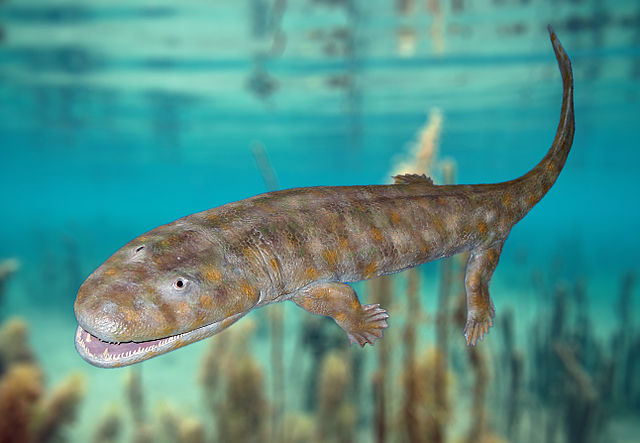
Model of the very early tetrapod Acanthostega gunnneri at State Museum of Natural History in Stuttgart.
Photo by Dr. Günter Bechly, Wikipedia, Creative Commons Attribution-Share Alike 3.0 Unported
| Tetrapoda | ||
| The Vertebrates | Overview |
| Vertebrates Home | Vertebrate | Vertebrate |
|
Abbreviated Dendrogram
Sarcopterygii
│
└─Tetrapoda
├─Ichthyostega
└─┬─Tulerpeton
└─┬─Crassigyrinus
└─┬─Colosteidae
└─┬─Baphetidae
├─Eucritta
└─Tetrapoda*
├─Temnospondyli
└─┬─Lepospondyli
└─Reptiliomorpha
|
Contents
Overview |
 Model of the very early tetrapod Acanthostega gunnneri at State Museum of Natural History in Stuttgart. Photo by Dr. Günter Bechly, Wikipedia, Creative Commons Attribution-Share Alike 3.0 Unported |
This unit is about the first animals on land, the first tetrapods or four-legged (as opposed to finned) animals. These were the first primitive amphibians, evolutionary groundbreakers, in more ways than one. Nevertheless, they were still mostly aquatic or semi-aquatic; legs evolved long before a life on dry land did. The first types, like the 60 cm long Acanthostega, shown above, and its slightly larger contemporaries and close relatives such as Ichthyostega and Hynerpeton, had not evolved far beyond being fish with legs, although from their wide distribution they were clearly still capable animals for all that. These ancestral types quickly radiated out into forms as diverse in appearance as eels and crocodiles. These sinuous creatures were among the top preditors of the rich and murky Carboniferous swamps. Nome lived past the end of the Carboniferous, victims perhaps to the drying out of the swamp lands that was part of the transition to the Permian and the start of the Age of Reptiles. But for as long as conditions allowed, these pioneering creatures were masters of their world. MAK111122
New page MAK111122